Uzbekistan Travel
-
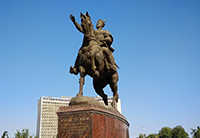
Amir
Timur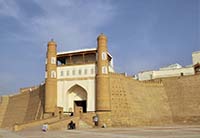
The Ark
Citadel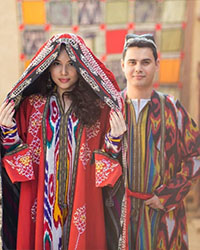
National
dress -
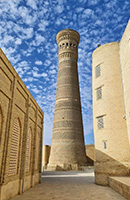
Kalan
minaret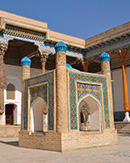
Bahauddin
complex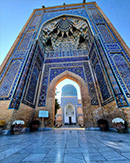
Gur-emir
mausoleum -
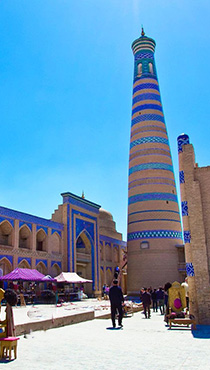
Islam
khodja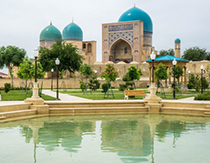
Dorut
Tilavat -
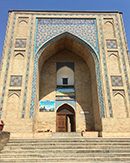
Kukeldash
madrasah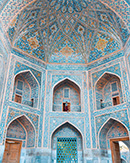
Poi kalan
festival tours -
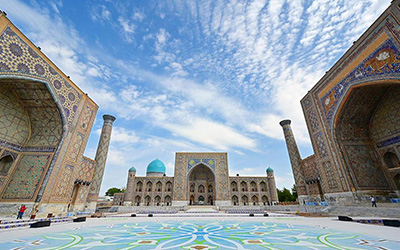
Registan
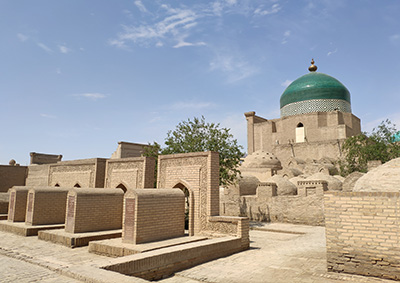
Pahlawan
Mahmud -
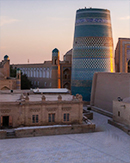
Kalta
Minaretadventure tours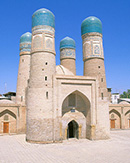
Char
Minar -
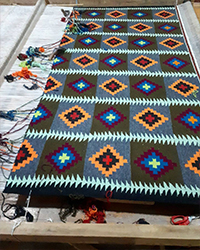
Handmade
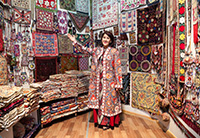
Tourist's
Testimonials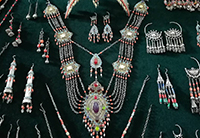
National
Jewellery -
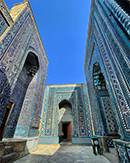
Shah-i
Zinda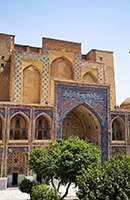
Ulugh
beg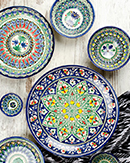
National
-
historical tour
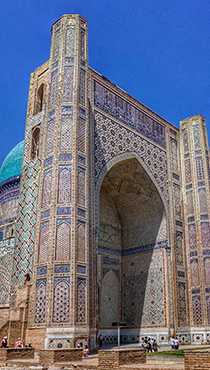
Bibi-khanym
mosque -
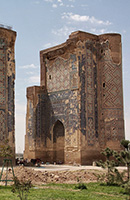
Ak saray
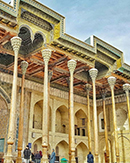
Bolo
haouz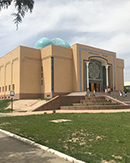
Termez
Uzbekistan
Uzbekistan is a land of historical cities were main points of trade on the Silk Road, linking Eastern and Western civilizations. Today the museums of Uzbekistan store over two million artefacts, evidence of the unique historical, cultural and spiritual life of the Central Asian peoples that have lived in the region. Uzbekistan is a treasure for tourists with its historical, archaeological, architectural and natural sites. And, it is brilliant opportunity to observe its culture, way of life and customs.
Tourist activities in Uzbekistan range from outdoor activities, such as rock-climbing, to exploration of its rich archaeological and religious history.
History
The history of Uzbekistan has witnessed important migrations that have changed the country's settlement due to the rise and fall of various dynasties and empires as well as powerful. It encompasses developments in the territory of the Republic of Uzbekistan from prehistory to the present. The territory of modern Uzbekistan was conquered by Alexander the Great, possessed by Early Turkic Khanates, converted by Arabs, ruled by Persians, raised by Turk Empires, destroyed by Mongols, restored by Timurids and finally became home of Uzbeks.


The territory of modern Uzbekistan was inhabited by Neanderthals back in the Palaeolithic. Uzbekistan is located in the interfluve, between the Amu Darya and Syr Darya rivers. These territory in medieval Arab and Central Asian sources was referred to as Maverannahr, in European sources - Transoxiana.
Uzbekistan is located in the centre of Central Asia, among the steppes, deserts and mountains, at the crossroads of major transport and trade routes. Uzbeks are the last link of this migration chain. Currently, Uzbekistan, the most densely populated independent country in the region, is trying to take its place in the ranks of the superpowers and to consolidate its self-identity. Samarkand, Bukhara and Khiva were the main cities during the history and they are well-preserved to our days.
Samarkand
Samarkand is the city that is one of the administrative centre of the 12 provinces of Uzbekistan. It is located in the Zerefshan River valley, 275 km southwest of Tashkent. It is the second largest city of Uzbekistan in terms of population, the most important city in terms of history and socio-cultural. Samarkand, which is among the oldest cities in the world with its history dating back 2500 years, has been an important settlement in terms of politics, economy and culture throughout history due to its location at an important junction of the Silk Road.


The city, which was founded by the Persians in the 6th century BC and became the centre of the Sogdiana region, was the centre of Sogdiana culture throughout the ancient period. Captured by Alexander the Great in 329 BC, the city continued to flourish during the Hellenistic period. After being conquered by Muslim Arabs in 711, it became one of the important cities of Islamic civilization. It was praised by eastern and western travellers as well as by Islamic geographers, and it was described in the sources as the dome of Islam and the foremost of the heavens on earth. The city was especially famous for its paper, and the best quality paper on Islamic lands was produced here. It was ruled by Iranian and Turkic dynasties until it was captured and destroyed by Genghis Khan in 1220. The period when Timur was the capital is considered the golden age of Samarkand. With the works commissioned by Timur and his sons and grandchildren in the 15th century, Samarkand became a city that hosts the best examples of Islamic architecture. Registan Square, where historical buildings that give Samarkand its magnificent appearance, took its present shape in the 17th century during the Bukhara Khanate.
Samarkand, which was occupied by the Russians in 1868 and became a part of the USSR, became the capital of the Uzbek Soviet Socialist Republic, which was established in 1924. It remained the capital of the Uzbek SSR until Tashkent became the capital in 1930.
Bukhara
The city is located on one of the old Silk Roads, had around 235,500 inhabitants in 2008 and is now one of the most important trade and industrial centres in Central Asia. Most of the city's residents are Tajiks and speak Tajik, the Central Asian form of Persian, as their mother tongue.
Archaeological findings have shown that the history of the city is at least 2500 years. In the archaeological section studies carried out in the city, in the lower layer of about 20 m; various archaeological finds such as public buildings, military fortifications, pottery and coins were found. Bukhara, one of the oldest settlements in the region, has an ancient history mixed with legends, and its first inhabitants are Turks compared to en-Narshahi. The same author recorded that the legendary Turan sultan Afrasyab (Alper Tunga) lived in Bukhara from time to time, and even his tomb was found in this city, which is important in terms of indicating that the Turkish presence in the region dates back to ancient times.
It is seen that human settlements around Bukhara, which was a Turkmen city until the 16th century, date back at least 5000 years. The city itself has a history of 2500 years. In history, Central Asia has been an important centre for Turkish civilization. The first settlements in Bukhara, which was under the control of the ancient Persian Empire for a long time, coincide with the Aryan migrations.
The historical centre of Bukhara with its architectural works of art, including numerous mosques and madrasas, has been a UNESCO World Heritage Site since 1993.
Not only with its ancient history, but also with its physical and geographical structure; its artistic and architectural texture; the wall and its castle; irrigation channels; its economic, agricultural and commercial potency; Bukhara, which made a name for itself in every period with its mansion, palace and markets, and the scholars and craftsmen it raised, remained under the rule of Turkish states for many years.
Although Transoxiana has many cities, towns, sub-districts and villages, the most popular and well-known of these is Bukhara. Muslims call it "Fahira" (precious) and accept it as the "Kubbetu'l-Islam" of the east.


Khiva
Khiva is in the province of Khwarazm. It is an independent city and also the capital of a district of the same name. The city is located west of the Amu Darya on the old Silk Road.
Although the name of the city is mentioned for the first time in the travel books of two Arab travellers who lived in the 10th century, archaeological findings show that its history goes back to the 6th century. It became the capital of the Khiva Khanate in the early 17th century. Khiva, which came under the control of Russia in 1873, was made the centre of the Khwarazm Soviet Public Republic, which was established in place of the Khiva Khanate, which was overthrown by the Red Army during the October Revolution. In 1924, it lost its political importance when it was annexed to the Uzbek Soviet Socialist Republic.
Historically, the city has always been of strategic importance due to its location on the route connecting India and Europe. Founded in the 6th century AD, Khiva 712 was conquered by Arab forces in the course of Islamic expansion, which led to the spread of Islam.
In the 10th century, Khiva was already an important trading town in Khwarazm. The Arab traveller and geographer al-Maqdisi, who toured the country in the same century, wrote: “Khiva is on the edge of the desert. It is a big city with an important Friday mosque”.
In 1220 the armies of Genghis Khan and in 1388 those of Timur conquered the city. It was not until the beginning of the 17th century that the city of Khiva became the capital of the Khiva Khanate, founded in Khwarazm in 1511, the successor state of the old historical empire Khwarazm.
The city's fortifications were often destroyed during the frequent sieges. The last time this happened in 1740, when Khiva was conquered by the Persian Nadir Shah and the khanate was part of the Persian Empire for a short time.
Finally, in 1873, Khiva was captured by Russian troops. From 1920 to 1925 Khiva was the capital of the People's Republic of Khwarazm. Subsequently, the city was part of the Uzbek Soviet Socialist Republic within the Soviet Union, since 1991 it has belonged to the sovereign state of Uzbekistan. In 1997 Uzbekistan celebrated the 2500th anniversary of the city of Khiva.
There are palaces, mosques, madrasahs and mausoleums in the old city, which is surrounded by walls, known as the İchan (Inner) Fortress. It gained the appearance of a museum-city as a result of the conservation program implemented in the USSR period in the 1970s and 1980s, and was included in the World Heritage List in 1991.


Territory & Nature
Nearly four-fifths of Uzbekistan’s territory, the sun-dried western area, has the appearance of a wasteland. In the northwest the Turan Plain rises 60 to 90 metres above sea level around the Aral Sea in Karakalpakstan. This terrain merges on the south with the Kyzyl-Kum Desert and farther west becomes the Ustyurt Plateau, a region of low ridges, salt marshes, sinkholes, and caverns.
Southeast of the Aral Sea, small hills break the flatness of the low-lying Kyzyl-Kum Desert, and, much farther east, a series of mountain ridges partition Uzbekistan’s territory. The western Tien Shan includes the Karzhantau, Ugam, and Pskem ranges, the latter featuring the 4,299-metre Beshtor Peak, the country’s highest point. Also part of the western Tien Shan are the Chatkal and Kurama ranges. The Gissar and Alai ranges stand across the Fergana Valley, which lies south of the western Tien Shan. The Mirzachol desert, southwest of Tashkent, lies between the Tien Shan spurs to the north and the Turkestan, Malguzar, and Nuratau ranges to the south. In south-central Uzbekistan the Zeravshan valley opens westward; the cities of Samarkand and Bukhara grace this ancient cultural centre.
The climate in Uzbekistan is continental, with little precipitation expected annually. Marked aridity and much sunshine characterize the region, with rainfall averaging only 8 inches (200 mm) annually. Most rain falls in winter and spring, with higher levels in the mountains and minimal amounts over deserts. The average summer high temperature tends to be 40 °C, while the average winter low temperature is around −23 °C.
It stretches 1,425 kilometres from west to east and 930 kilometres from north to south. Bordering Kazakhstan and the Aralkum Desert (former Aral Sea) to the north and northwest, Turkmenistan and Afghanistan to the southwest, Tajikistan to the southeast, and Kyrgyzstan to the northeast, Uzbekistan is one of the largest Central Asian states and the only Central Asian state to border all the other four. Uzbekistan also shares a short border (less than 150 km) with Afghanistan to the south.


It stretches 1,425 kilometres from west to east and 930 kilometres from north to south. Bordering Kazakhstan and the Aralkum Desert (former Aral Sea) to the north and northwest, Turkmenistan and Afghanistan to the southwest, Tajikistan to the southeast, and Kyrgyzstan to the northeast, Uzbekistan is one of the largest Central Asian states and the only Central Asian state to border all the other four. Uzbekistan also shares a short border (less than 150 km) with Afghanistan to the south.
Uzbekistan is home to six terrestrial ecoregions: Alai-Western Tian Shan steppe, Gissaro-Alai open woodlands, Badghyz and Karabil semi-desert, Central Asian northern desert, Central Asian riparian woodlands, and Central Asian southern desert.
Uzbekistan Travel Seasons
The best seasons for visiting Uzbekistan are spring and fall. During the time between March and May, the temperature is ideal for outdoor activities. In these period, you will have the perfect weather for your tourist benefit because the winter chill fades away, but the summer heat has not set in. Rainfall is rather possible but not in the high degree so it will not make your plans difficult. Following the winter cold, the temperature starts getting warm, not too hot.
Before the summer heat, this is a great opportunity to travel through the Silk Route, and the Golden Valley. It can be the greatest time to spend a night at the Kyzylkum Desert. The Silk and Spices Festival organized in May, which you can experience Uzbek arts, crafts, and traditions and it is the best place to pick up the best souvenirs.
Cool
Rainy
Rainy
Sunny
Sunny
Warm
Sunny
Windy
Sunny
Windy
Sunny
Hot
Sunny
Warm
Sunny
Warm
Cloudy
Cool
Cloudy
Snowy
Cold
Snowy
Cold
Snowy
If you are looking for perfect opportunity for exploration far from heat of the summer and the crowd of tourists, the fall weather in Uzbekistan from September to November is also pretty ideal. By September, the summer heat starts to cool down. This period before the winter starts is one of the best times to visit Uzbekistan as the weather is stunning, and the crowds would have also dissipated. This is another shoulder season, so you do not have to abide by a strict schedule. To experience the best of the cuisine, best time when the country goes into harvest.
If you are a summer traveller and do not care about summer heat, June is still bearable, the temperatures begin climbing up by July. July and August are the hottest months in Uzbekistan, and it gets incredibly humid and balmy. However, this is high season due to school holidays, and holidays in Europe, so it is expected a lot more tourists during this season. The Fergana Valley is better choice, where it will be slightly cooler than deserts. You can also explore Tashkent, when all the crowds are there, as it will turn into a lively city.
Even, if you love winter, Uzbekistan’s winter can be cold, but still mild compared to other countries in Central Asia. January and February are the coldest months, but even then, the temperatures do not drop too far below zero. Expect strong winds which will make the cold worse, though. However, huge discounts you get can make it bearable because it is a low season during winter. You will be able to take magnificent photographs, because the sky is extremely clear, and there are little to no visitors in the country. This is a great period to visit Tashkent, and explore its beautiful galleries and markets, without concerning about the tourist raid.


HOW TO TRAVEL AROUND Turkmenistan?

Airlines
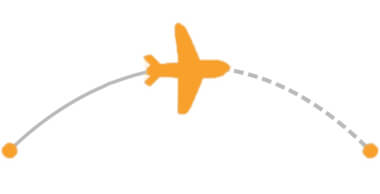






































Is Uzbekistan safe to travel?
Uzbekistan is the world’s safest country
Countries in Central Asia – Kazakhstan, Kyrgyzstan, Tajikistan, Turkmenistan, and Uzbekistan are considered Level 1 countries by the US Department of State that means they are among the safest countries in the world to travel.
People in Uzbekistan are hospitable and glad to receive foreigners in their country. You are in the right place, if you are wondering about visiting Uzbekistan as a solo (female) traveller, backpacking around independently with your friends or family. It is safe for students live in its capital city Tashkent.
Many cities in Uzbekistan like Samarkand and Bukhara have touristic police dedicated to the safety of foreigners visiting the country. The Uzbek government is putting out initiative every year to attract tourism and the country overall is very safe. You can feel yourself safer there than in some parts of Europe. However, petty crime such as pickpocketing can happen anywhere and especially in crowded areas.
In Uzbek culture, men do not tend to approach foreign women very often. While traveling around the country by herself, women are never bothered by guys. Uzbekistan is very safe for solo female travellers and despite the annoying taxi drivers whom you actually find all over the world.The people are genuinely friendly and helpful. They are very curious about foreigners and especially in towns or villages, you can certainly expect to get invited for a tea or a meal.
Tashkent is the modern and clean city. There are beautiful parks where families come to relax and sit in the shade of trees. It is a city that attracts a lot of students and expats and you can understand why. The level of safety there is extremely high. This is in part due to the presence of touristic police in the centre of the city.
In the parks or the streets of Tashkent, you can be often approached by young Uzbek students wanting to practice their English. People in Tashkent are extremely welcoming and will definitely make you feel at home. There is nowhere in the world are children as sacred as in Central-Asia. In the Uzbek culture, children are very important and are treated with the utmost respect and love.
The major highways connecting the country are in a reasonable state but roads in the Tien Shan and Fan Mountains, are generally in poorer condition than in other parts of the country and may only be passable by four-wheel-drive vehicles. Driving at night in Uzbekistan can be dangerous because vehicles share the roads with livestock and carts pulled by horses and donkeys. The speed limit in Uzbekistan is 50km/h inside towns and cities and 100km/h on highways. Buses and trains in Uzbekistan are considered very safe and a great way to travel around the country. Trains in Uzbekistan are considered the safest and most comfortable mode of transport.
Food in Uzbekistan is very safe and very delicious. The Uzbek cuisine is characterized by dishes that consist mainly of rice, noodles, vegetables and lots of mutton. As a vegetarian, it can be challenging but not impossible to find meat-free meals, but if you are a vegan, it will be very hard to eat a typical Uzbek meal.


Holidays and Festivals in Uzbekistan
Holidays and festivals do not differentiate from other Central Asian countries in Uzbekistan. Except national holidays like independence and constitutional holiday, religious and global holiday are celebrated by locals at the same with the Muslims and peoples all over the world. New Year and International women’s day are global holidays are valid in Uzbekistan. Ramadan and Qurban Holidays are both Islamic and national holidays and celebrated due to Lunar Calendar.
National holidays are: Day of defenders of the Native Land (January, 14), Nowruz (March, 21), Day of memory and honour (May, 9), Day of Independence (September, 1), Day of teachers and instructors (October, 1), The Constitution Day (December, 8).
Day of defenders of the Native Land is the holiday in Independent Uzbekistan is celebrated in honour of creation of Army forces of Uzbekistan.
Nowruz holiday is the most ancient holiday of all Turkic nations and celebrated in 21st March in all over the Turkic world.
Day of memory and honour is in the same spirit with the Victory Day of Russia. Uzbekistan and other Central Asian countries fought against fascism within then Soviet Army. The only difference of this holiday includes some national heroes and representatives of Uzbek nation.
Day of Independence, Day of teachers and instructors, and The Constitution Day are other national holidays celebrated in Uzbek country.
There is a variety of yearly festivals held in Uzbekistan, too. They are very popular with the people and treated as holidays. One of them is the folk festival "Boysun Bakhori" ("Boisun's spring"), which is held in the mountainous Boysun District, Surkhandarya Province. The people of Boysun consider themselves to be the descendants of the legendary Alpamysh. They tell stories about him and his deeds relevant to surrounding gorges and villages. Thus it is no wonder that along with 19 other regions in the world, in 2001 Boysun District was included in the UNESCO List of "Masterpieces of the Oral and Intangible Heritage of Humanity".


Uzbekistan Traditions and Customs
The Uzbek culture has much in common with the culture of other Muslim countries, but nevertheless it has its own features. A great number of rites and customs accompany the Uzbek family life. Weddings are considered to be the most important event in one's life. Preparations for this special occasion begin from the birth.
Uzbeks love to gather in big groups and entertain the whole village (kishlak) or mahalla (community in cities) on family occasions. Mass people's festivities are widely celebrated. They are followed by various ceremonies, festive bazaars at which musicians, dancers, wrestlers perform. Uzbeks are very friendly and hospitable people. To the traditional forms of social relations in Uzbekistan belongs first of all “Mahalla”. Uzbek “Mahalla” has rich and ancient history and is the centre of family and religious ceremonies and festivals. They say: "If one does not have delicious food for a guest, one should have sweet words for him". Uzbeks are supportive of each other.
The ancient custom of Khashar is a unique form of mutual assistance. If a fellow-villager finds himself in difficulty, all the neighbours gather to help him. Mutual assistance reveals itself also while preparing for wedding and circumcision parties, house building, and funeral ceremonies. Uzbeks traditionally have respect for older people.
Wedding (Toy) - traditionally neighbours, colleagues, relatives from near and far cities and settlements, friends and acquaintances from mahalla are invited for the ceremony, so in the end it comes as several hundreds of people. In this connection for last decades in the cities they have built capacious wedding restaurants which are called toykhana.
Beshik Toy – a ritual solemnity related to the first put of the baby into the cradle. This is one of the most ancient and widespread ceremonies in Uzbekistan. Usually this event is held on the 7th, 9th, 11th day after the birth of the baby.
Sunnat (Circumcision) is another ancient Uzbek ceremony adopted after accepting Islam (Sunnat Toy). This circumcising ceremony is held for boys at ages 3, 5, 7, 9 but nowadays this aging is not strict and one can do this ceremony when needed.
Ceremony of the morning palov usually held during the wedding and memorial services, other holidays like birth of child or anniversaries.


Uzbek Cuisine
Uzbek cuisine shares the culinary traditions of Turkic peoples across Central Asia. There is a great deal of grain farming in Uzbekistan, so breads and noodles are of importance. Mutton is a popular variety of meat due to the abundance of sheep in the country and it is a part of various Uzbek dishes.
The history of Uzbek cuisine and the origins of the various Uzbek dishes can be traced back several centuries. Therefore, the traditional rituals that are still common today when preparing food can be explained. Today, as it was several centuries ago, Uzbek cuisine is closely linked to the oriental cuisine and the cuisines of other Turkish-speaking countries due to the location, language, culture and religion of Uzbekistan. Russian influences are also present.
Uzbek cuisine is very varied, with more than a thousand dishes. Typical of Uzbek cuisine are soups such as chorba and narin, the bachor (salad), the main courses plov or manti as well as lagman - which is served both as a main course and as a dessert - and halva. Green tea in particular is drunk all year round in tea houses, the so-called chaikhanas. In summer, however, ayran, a chilled yogurt, and fruit juices are preferred. Alcoholic beverages are generally not very popular, with the exception of wine, which, for a predominantly Muslim country, is consumed a lot. The most popular wines in Uzbekistan are Gulyakandoz, Shirin, Cabernet and the Aleatiko. Beer is mostly imported, such as the famous Baltika or Heineken.
The national dish of the country is the rice dish plov, which is prepared differently in each part of the country and of which there are more than 500 types of preparation.
The main foodstuffs are rice and bread, which used to be considered sacred and around which there are numerous legends. The main bread eaten is flatbread, which is still baked in the traditional way on the inside of a large clay oven (tandyr). Furthermore, in Uzbekistan - as in other Turkish and Muslim countries - a lot of kebab and sesame are eaten. Read more


Flora and Fauna
Vegetation patterns in Uzbekistan vary largely according to altitude. The lowlands in the west have a thin natural cover of desert sedge and grass. The high foothills in the east support grass, and forests and brushwood appear on the hills. Forests cover less than 8 percent of Uzbekistan’s area. Animal life in the deserts and plains includes rodents, foxes, wolves, and occasional gazelles and antelopes. Boars, roe deer, bears, wolves, Siberian goats, and some lynx live in the high mountains.
The lower altitude hills display low herbaceous cover known as savannoids, with Bulbous meadow-grass, sedges, and Artemisia. Biodiversity is high, with over 2,000 species of plants recorded in the region. Higher elevations see ephemeroid grasses such as Elytrigia and Bulbous barley.
Flora communities reflect altitude zones. Below 1800-2000 meters the desert foothills are characterized by sagebrush, bulbous bluegrass, and sedges. At higher elevations are meadows and grasslands dominated by fescues. Junipers, wild fruit trees (cherry, pears, apples) and nut trees (almonds, pistachios) grow along with steppe grasses and shrubs of Cotoneaster, rose, and honeysuckle.
Biodiversity is high in the region, as the climate is relatively mild, and the location is in a transition zone that supports both Iranian-Afghan and Central Asian floral communities. Over 1,100 species of vascular plants have been recorded in the region. The dominant plants are desert sedges, particularly. Also found are Artemisia shrubs, Saltwort, and Saxaul. Protected areas have been set aside to protect groves of the wild Pistachio trees, with one covering 760 km2.
The region supports important populations of large mammals, such as the near-threatened Asiatic wild ass (Onager) and the Goitered gazelle. The endangered Egyptian vulture is also found in the region. Mammals of the Central Asian northern desert include the long-eared hedgehog, tolai hare, various species of gerbil and jerboa, saiga antelope, steppe polecat, goitered gazelle, onager and suslik. Birds of this ecoregion include wheatears, desert warbler, brown-necked raven, the endangered houbara bustard, black-bellied sandgrouse, golden eagle, steppe eagle, Egyptian vulture, and the saker falcon. Numerous reptiles can be found in this ecoregion, including numerous Agama lizards, Rustamov's skink gekko (Teratoscincus scincus rustamovi), Chernov's snake-lizard (Ophimorus chernovi), Ferghana sand lizard (Eremias scripta pherganensis), desert monitor (Varanus griseus) and the Central Asian cobra (Naja oxiana).
The invertebrate fauna of this ecoregion is quite rich, especially in the sandy deserts, supporting a variety of grasshoppers, beetles, butterflies, termites and ants.
The woodlands of this ecoregion are a specialized complex of woody-shrubby vegetation known as tugai, which adapts to the extreme continental climate that experiences very hot summers and very cold winters. For all practical purposes there are no old-growth forests. Trees are typically poplars, willows, dzhidda (a type of silverberry), and Tamarix. Underbrush includes sea-buckthorn, barberry, briar roses, honeysuckle, and Cotoneaster. Reeds and cattails are found extensively in the wetlands. The forest complexes of the ecoregion are often patchy, interspersed with steppe and swamp meadows.
Soil type and quality is one of the main drivers of plant species across the ecoregion. Sandy areas typically feature White saxaul and Black saxaul, which are short hardy trees that are tolerant of drought and poor soils. They have extensive root systems to hold in the sand. Thin sandy and loamy soils support many species of sagebrush and salt-tolerate saltworts. Saline solonchak soils support salt-tolerant succulent semi-shrubs such as Halostachys, Halocnemum strobilaceum and Seepweeds.
Common mammals include the long-earned hedgehog, Brandt's hedgehog, and Tolai hare. Also common are gerbils and ten species of jerboas.

